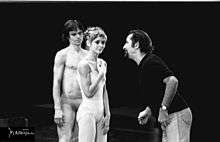Maurice Béjart
Maurice Béjart (French: [beʒaʁ]; 1 January 1927 – 22 November 2007) was a French-born dancer, choreographer and opera director who ran the Béjart Ballet Lausanne in Switzerland. He was awarded Swiss citizenship posthumously.
Maurice Béjart | |
|---|---|
_by_Erling_Mandelmann_-_2.jpg) Béjart in 1988 | |
| Born | Maurice-Jean Berger 1 January 1927 Marseille, France |
| Died | 22 November 2007 (aged 80) Lausanne, Switzerland |
| Occupation | Dancer, choreographer and opera director |

Biography
Maurice-Jean Berger was born in Marseille, France in 1927, the son of French philosopher Gaston Berger. Fascinated by a recital of Serge Lifar, he decided to devote himself entirely to dance. In South France days, he had studied under Mathilde Kschessinska.
In 1945, he enrolled as a corps de ballet at the Opéra de Marseille. From 1946, he had studied under Madam Rousanne (Sarkissian), Léo Staats, Madam Lyubov Yegorova and Olga Preobrajenska at "Studio Wacker", etc. in Paris.
In 1948, he also trained with Janine Charrat, Yvette Chauviré and then with Roland Petit, in addition he had studied under Vera Volkova at London.[1][2][3]
In 1954, he founded the Ballet de l'Étoile company (dissolved in 1957). In 1960 he founded the Ballet du XXe Siècle in Brussels (dissolved in 1987).
_by_Erling_Mandelmann_-_3.jpg)
In 1987 he moved to Lausanne in Switzerland, where he founded the Béjart Ballet Lausanne, one of the most famous and successful dance companies in the world.
In 1973, with the Ballet du XXe siecle, he premiered "Golestan", on a poem by Sa'di, based on Iranian traditional music. The ballet was commissioned by the Shiraz-Persepolis Festival of Arts where it was premiered. The first performance of "Improvisation sur Mallarme III" with music by Boulez also took place at that Festival in 1973. "Farah", also based on Iranian traditional music was the Ballet's own commission, premiered in Brussels in 1976 and brought to the Shiraz-Persepolis Festival that same year. The 1976 Festival also witnessed the first performance of "Heliogabalus", based on a poem by Artaud. The Festival's patron was Farah Pahlavi, the former Empress of Iran, with whom Béjart kept strong ties to the end. Béjart received the Deutscher Tanzpreis in 1994.
Among his works is a thoroughly revised version of The Nutcracker, presumably inspired by his own life story, which he staged in 2000. It still uses Tchaikovsky's original score, but completely scraps the original plot and characters, instead supplying a new story about a boy's efforts to re-connect with his mother. We also are given a look into the boy's strange sexual fantasies. The production design is full of erotic images — some of which are most likely shocking to many, such as wombs and vaginal openings. One of the characters is Marius Petipa, who becomes Mephisto. Another character is called Felix the Cat, presumably after the famous cartoon character. The production has been issued on DVD.
Boléro
One of Béjart's masterpiece works of dance was choreography he set to French composer Maurice Ravel's "Boléro." In The New York Times, Jennifer Dunning described Béjart's "Bolero" as "probably his best known and most popular dance."[4] Created in 1960 for the Yugoslav ballerina Duška Sifnios, the dance features a dancer on a tabletop, surrounded by seated men, who slowly participate in the dance, culminating in a climactic union of the dancers atop the table.[5] Amongst the dancers, who would later perform Béjart's interpretation of "Bolero," include Sylvie Guillem from the Paris Opera Ballet, Grazia Galante, Maya Plisetskaya, Angele Albrecht, and Roberto Bolle. In a twist, Jorge Donn also played the role of the principal dancer, becoming the first male to do so. One of Donn's such performances can be seen in French filmmaker Claude Lelouch's 1981 musical epic, Les Uns et les Autres.
Dance schools
Béjart was the founder of several dance schools:
- the Mudra School in Brussels, 1970–1988;
- the Mudra Afrique School in Dakar, 1977–1985;
- the Rudra School in Lausanne, 1992–2007.
The Rudra School is still open and is one of the most famous professional dance schools in the world.
Awards
During his lifetime, Béjart received many awards and distinctions for his contributions to the arts.[6]
He received the Japanese Order of the Rising Sun.
He received the Belgian Ordre de la Couronne.
In 1974, he won the Erasmus Prize.
In 1994, he was appointed to the Académie des Beaux Arts.
In 2003, he was appointed Commandeur des Arts et des Lettres.
In 2003, he won the Prix Benois de la Danse for lifetime achievement.
Filmography
- 1975: Je suis né à Venise with Jorge Donn, Shonah Mirk, Philippe Lison and Barbara
References
- Maurice Béjart
- Béjart, Maurice (1927-2007) Archived 2012-02-04 at the Wayback Machine
- "Maurice Béjart 1922~2007" Shinsokan Dance Magazine, Special Issue Volume XVII No.4 2008, Japan
- Dunning, Jennifer (November 25, 1985). "Dance: Bejart Company Performs 'Bolero'". The New York Times. Retrieved February 20, 2016.
- Anderson, Jack (June 8, 1990). "Review/Ballet; Fashion Merger: Dance, Dollars And a New Scent". The New York Times. Retrieved February 20, 2016.
- Cruickshank, Judith (November 24, 2007). "Maurice Béjart: Influential choreographer who attracted huge audiences to ballet". The Independent. Retrieved January 20, 2016.
External links
- Béjart Ballet Lausanne
- Rudra Béjart School
- Publications by and about Maurice Béjart in the catalogue Helveticat of the Swiss National Library
- Obituary in The Guardian UK
- Lisa De Rycke (2005). "Maurice Béjart". In Andreas Kotte (ed.). Theaterlexikon der Schweiz (TLS) / Dictionnaire du théâtre en Suisse (DTS) / Dizionario Teatrale Svizzero / Lexicon da teater svizzer [Theater Dictionary of Switzerland] (in French). 1. Zürich: Chronos. p. 150. ISBN 978-3-0340-0715-3. LCCN 2007423414. OCLC 62309181.